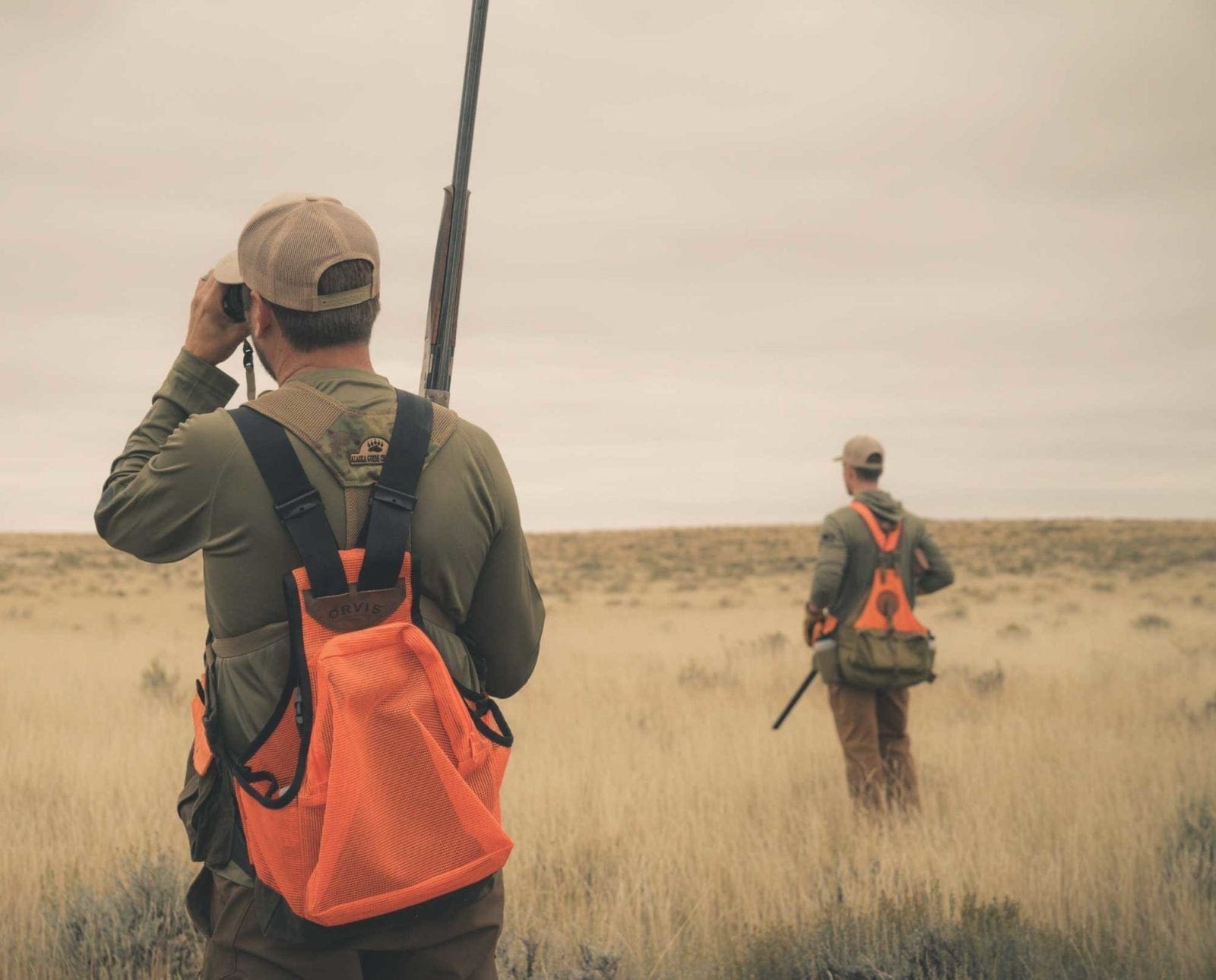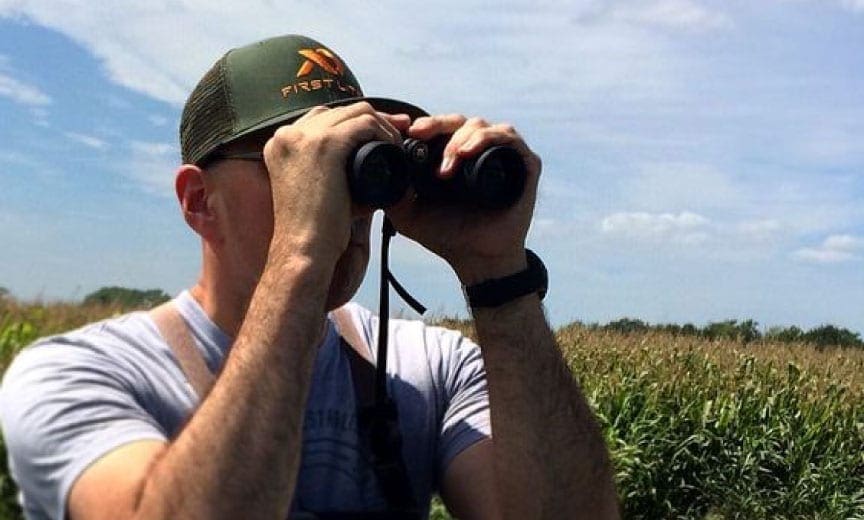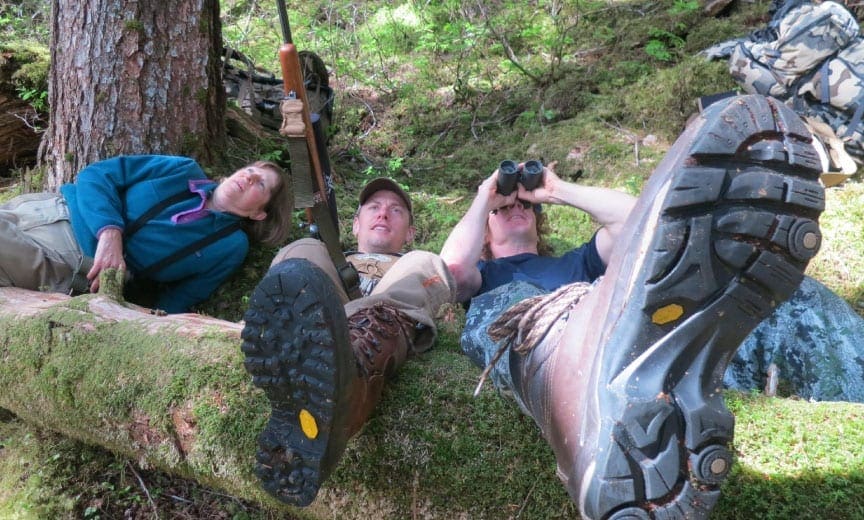
Edgar Castillo is a recently retired law enforcement officer for…
Exploring the unorthodox approach of using binoculars for upland bird hunting
Somewhere out there in all the trees, tall and short grass, rimrock, and hillsides, there are birds. Nearly every article a hunter reads concerning binoculars is about the technical side. The basis for using optics, whether it be a spotting scope or binoculars, in any hunting situation is that a hunter cannot hunt what they cannot see. Normally associated more with big game hunting, the use of binos is a good way to locate and catch birds coming and going. Glassing for upland bird hunting is an often overlooked, underutilized, or ignored tactic. Although binoculars are not required when upland hunting, they are an invaluable tool when used. The use of binoculars for wingshooting, although unorthodox, is a valuable pairing.
It would be safe to say that most bird hunters probably have a set of binoculars stashed somewhere in their vehicle when they go hunting. They are an essential piece of equipment for any hunter. As vital as they are, how many bird hunters utilize binoculars to help them on their feathery quest? Binoculars have their place in upland hunting. Knowing when and how to use them is key to their usefulness and actual worth in a wingshooter’s bag of tricks.
Turkey hunting is a more obvious application
Let’s start with the obvious benefit and general use for binos: turkey hunting. When chasing ol’ Tom, hunters have their work cut out for them. The turkey’s acute and exceptional vision is its main line of defense. By this, binoculars then become the best tool for hunters to match wits with wild turkeys and their incredible eyesight and sense of danger. Binoculars should be put to practical use from start to finish.
It begins during the pre-season scouting treks to determine where turkeys go at different times of the day, and most importantly, where they go to roost in the evening. When hunters are scouting, what they want to avoid is getting too close to turkeys. Binoculars allow hunters to observe from afar, judging a group of turkeys, determining how many longbeards, jakes, and hens there are in a flock or rafter. Hunters should avoid pressuring turkeys and making them nervous. This may cause them to move off their normal locations and change their daily routines and patterns.
Where binoculars really come into play while in the spring turkey woods is when the hunt is on. It’s go-time. Binos really show their value when hunters need the ability to scan distant fields and areas. By remaining at a safe distance before moving in closer to setup, gobblers can be gauged by their size and beard length.
Just as important as the mature tom that hunters are after, young of the year jakes and hens play an essential part in determining how many sets of eyes a hunter must fool prior to setting up for the call to lure a big tom in.
Using binoculars for dove hunting
The second clear use for binoculars comes during dove season. Dove hunters conducting pre-season scouting sitting in truck cabs or standing in the beds to track dove movements will pay off come opening day. Prior to the start or even during the dove season, learning the flight lanes on good dove fields is a good strategy that can pay off with a limit of gray birds.
READ: A Complete Guide to Dove Hunting
Learning flight patterns prior to the dove opener can be a rewarding step.

Watching a large area with binoculars and counting the number of doves that move in or near potential places can help determine a good place to sit. By drafting a sort of mental activity log, hunters may locate areas where several flight patterns cross. These intersections are excellent places to set up and place out decoys. Binos will allow hunters to better understand the lay of the land and fields. Knowing the landscape and terrain will help guide dove hunters to the best place with the most action.
Using binoculars also plays an important role in hunter safety. This is especially true during dove and turkey season. Binos allow hunters to glass near and far to determine what sort of movement caught their eye. Could it be another hunter moving in, maybe it’s a doe and fawn feeding, or another mature gobbler moving in covertly after hearing the hunter lay down some cuts and yelps.
Less conventional use for upland game birds
Now let’s dive into the more unconventional types of upland birds where hunters could benefit from using binoculars. It would be safe to say the use of binoculars in assisting hunters in their pursuit could be applied to practically most upland game birds. Prior to stepping off, hunters can use binoculars to glass fields, grasslands, and a host of habitats and terrain.
One way to utilize binoculars into a bird hunt is to scan distant slopes, ridges, and hillsides, looking for feeding or roosting birds. After birds are located, then develop a method of approach. Depending on the terrain, using binos as hunters close the distance along the way will help them maintain a visual as well as using caution so as not to cause birds to prematurely flush. The closer hunters get, listening for sounds such as clucks and cackles will also help in determining location.
Other ways to find birds with binos is to watch or scan the skyline for flight plans. Follow birds on the wing to patches of shady cover or food. Watch for prairie chickens and sharp-tails during the early season in the mornings or midafternoon as they take to shady spots along hillsides that may provide relief from the heat. Binoculars are also handy when glassing feed fields or short grassed ridge tops for these prairie birds. These birds on occasion appoint a sort of lookout.
READ: How to Identify the Difference in Prairie Grouse on the Hunt
Sometimes perched atop hay bales, in cut grain fields or in thin knee-high grass watching for danger, the lookout resembles a sort of bobbing bowling pin. I have used this glassing technique prior to approaching an area known to hold birds. It helped that I knew the prairie chickens used a relatively flat and sparse hilltop to loaf. The birds were easy to see walking around including the sentries waiting to sound off an alarm.
Scouting from roads that traverse or are adjacent to lands that are open to hunting or agricultural fields is a good way to locate doves, pheasants, and Huns. After feeding in the morning, birds that are near gravel roads or dirt lanes may use these places to seek out grit. They will repeat this pattern in the evening before going to roost. I have read that mountain and valley quail, and ruffed grouse, can be found using logging roads. Here they eat various clover, grass, and insects, as well as collect grit. They often get water from roadside puddles and ditches. Watching birds on the road from afar using binoculars will help hunters establish known locations where birds are and the type of habitat they are using.
Birds that reside and survive in the open terrain such as the desert or sage, binoculars can be very handy in scouting the land. Glassing for water sources and finding guzzlers that are crucial to desert quail and sage grouse can help cover vast areas.
For those birds that dwell in extreme terrain, such as chukars and snow cocks, bird hunters need to rely on their eyes. Better yet get those binoculars out and glass the slopes, ridges, rocky outcroppings, and mountain tops. The best approach is to cover as much ground as possible. A quick glance through binos can also show of any signs of other hunters in the area hunting the property. If hunters are present, follow their movements and watch and wait.
By watching other hunters push through an area, you can note if birds take to the air and see where they land. If the party leaves without chasing those birds that flushed, then the opportunity is there to go after them.
Binoculars also assist in determining which lands to avoid, too. Binos help hunters make their way through the uplands or locate that missing truck after a long day in the field.
Using binoculars during the spring hoot
An excellent example of a hunter using binoculars for bird hunting is none other than Steven Rinella, of Meat Eater fame. Binoculars were vital in his hunt for sooty grouse. Besides tracking the unique sound emitted from the males, binoculars were pivotal in Steven locating the bird high up in the tall trees.

By glassing the tallest trees and looking for movement, Steven was able to harvest several birds. Without using binoculars, Steven would have never been able to find sooty grouse. It was the most important piece of equipment used by Steven on the hunt.
Granted, there are plenty of bird hunters out there whose hunting style and conditions will not require the use of binoculars, but for some, they will learn to embrace their worth in the field.
Choosing binoculars
Binoculars come in a variety of sizes, so finding a pair that can be carried is relatively simple and easy. Compact optics will fit easily in most bird vests, while larger pairs of binos can be housed in specially made pouches. These bino-hubs offer convenience, protection, efficiency, and options. The binocular chosen should be the best a hunter can afford. The likely scenario being that the bino will be doing double-duty glassing for deer and other big game animals when not bird hunting. A general magnification of 8x is well suited for most terrain and applicable bird hunting situations.
In the end, knowing food and habitat preferences for the upland bird one is hunting will help find promising hunting grounds. Binoculars are a mere resource and another tool on a hunter’s belt. How a bird hunter chooses to apply them in settings is up to each person. So, the next time you go afield, take a moment, and rethink the idea that binoculars are not only for glassing big game, but equally as important and practical when upland hunting.
Edgar Castillo is a recently retired law enforcement officer for a large Kansas City metropolitan agency. He also served in the United States Marine Corps for twelve years. Edgar longs for the colors of autumn and frosty, winter days so he can explore the landscapes in search of wild birds in wild places. His passion lies in the uplands as he self-documents his travels across public lands throughout Kansas hunting open fields, walking treelines, & bustin’ through plum thickets.




I generally have binos in my rig but do not carry them. They are handy to take an initial peak. I will trust the noses on my best friends over sight every day. It’s not really hunting if dogs are not part of it.
Zack…I’m with ya, well for most of it. I use my binos from the confines of my truck or standing in my bed, but when I prairie chicken hunt I have found it helps. Birds tend to be already spooky and it helps work the dogs in certain places. Thanks for the comment.
I use binoculars from the pickup all the time for birds, but now I’m going to have to figure out if my bino harness is compatible with my game vest. Great idea
Kyle…thanks for reading my article and even better that it may have provided some helpful info. I have an LL Bean adjustable bino harness which Keeps em close and not bouncing around. On occasion I’ll wear my hun thorn bino case with same features. Binos don’t have to be big…throw a small pair in your vest.
Glassing is just good practice for any outdoorsman. You see things you normally don’t. DA!! But for some reason it has lost its place among us. My dad was a very patient man. We could be outdoors or even in the city and he would take out his binos and then point out to me some kind of a wildlife somewhere in the distance. I’ve seen the value of it. We hunt chukars mainly. We used to hunt a place where we had to park down below and hike up and then start hunt. There were times where we got out of the truck and while my buddies were just getting ready, I had already spotted a covey up on the rocks. I have a midsize Steiner I use. Love that thing.
I agree with you for the most part. I think as birdhunters we tend to forget that glassing can be useful and helpful in our pursuit. Whether it is quail, roosters, grouse, chickens, or chukars. I use it more for chickens, however I have found myself reaching for the binos to scout the land as well and for birds.